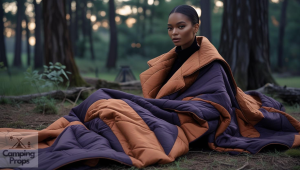Choosing the right camp blankets can make a huge difference in your outdoor comfort. Whether you’re tent camping in the woods, sleeping under the stars, or lounging by a fire pit, having the proper blanket keeps you warm, cozy, and protected from the elements.
In this guide, we’ll break down how to choose the best camp blankets based on materials, temperature ratings, weight, packability, and more.

🧵 1. Choose the Right Material for Your Needs
Camp blankets come in various materials, each with its pros and cons:
-
Fleece: Lightweight, warm, and soft. Great for dry, cool nights.
-
Wool: Naturally insulating and moisture-resistant. Ideal for colder weather.
-
Down: Ultra-warm and compressible but needs to stay dry.
-
Synthetic Insulation: A great all-weather option. Less expensive and retains warmth even when wet.
🟢 Tip: If you’re unsure about the weather, go for a synthetic or wool blanket — they’re more versatile.
🧊 2. Temperature and Insulation
Think about where and when you’ll be camping. Some camp blankets are designed for summer nights, while others can handle freezing temps.
Look for these features:
-
Temperature Rating: Choose a blanket rated slightly lower than your expected nighttime lows.
-
Insulated Layers: More insulation = more warmth.
-
Windproof/Water-Resistant Shells: These features help block cold wind and moisture.
🧳 3. Size and Coverage
Camp blankets come in various sizes:
-
Single: Compact and lightweight — best for solo campers or kids.
-
Double: Great for couples or wrapping around yourself completely.
-
Oversized: Ideal if you want full-body coverage or plan to use it picnic-style.
Make sure your blanket is large enough to fully wrap around your body or cover your sleeping area.
🎒 4. Packability and Weight
Campers, backpackers, and van-lifers all have different needs:
-
Backpackers: Look for ultralight and compressible blankets (down or technical synthetics).
-
Car Campers: Weight matters less — go for maximum comfort.
-
Day Trippers: A packable fleece or compact insulated throw is perfect.
🟢 Look for included stuff sacks or straps that make packing easy.
💧 5. Water Resistance and Durability
Many camp blankets now feature water-resistant shells or coatings. This is especially useful if you’re dealing with:
-
Damp ground
-
Morning dew
-
Accidental spills
Also, check reviews for durability — camp blankets should handle dirt, sand, and frequent use without tearing or pilling.
✨ 6. Extra Features to Look For
Modern camp blankets come with useful extras:
-
Snaps or zippers: To convert into a sleeping bag or wearable poncho.
-
Loops: For securing to sleeping pads or hammocks.
-
Stuff sacks: For compression and storage.
-
Recycled Materials: A growing number of brands use eco-friendly materials.
✅ Best Use Cases for Camp Blankets
Here are some scenarios and which blanket types work best:
| Use Case | Ideal Blanket Type |
|---|---|
| Summer Tent Camping | Lightweight fleece or synthetic throw |
| Fall/Winter Camping | Insulated down or wool blanket |
| Backpacking | Ultralight down blanket |
| Car Camping | Oversized, plush synthetic |
| Beach/Park Picnic | Durable, water-resistant base blanket |

The right camp blanket can elevate your camping experience — offering comfort, warmth, and peace of mind no matter where you sleep. From ultralight options for hikers to thick, cozy throws for car campers, there’s a blanket out there that matches your needs and style.
Choose wisely and stay warm!
Explore more tips in our Camping Hammock Guide.
Leave a Reply